I was hoping 52Audio.com would perform a teardown of the Sony WF-H800 and it looks like they have jut posted it up on their site today. I will not be posting all the photos here, so do check out their full teardown on their site for the full teardown.
The initial teardown of the WF-H800 from the FCC was not that detailed but it did confirm that most of the parts were shared between the WF-H800 and the WF-1000XM3. For a comparison to the WF-1000XM3 teardown, check out this post.
Comparing the cases first, it looks like the weight of the WF-H800 case (without earbuds) is 45.5g, the WF-1000XM3 case for comparison is 75.2g, almost 30 grams more. This difference is mostly down to the smaller battery capacity in the WF-H800, 300mAh/1.11Wh.
 |
| Sony WF-H800 case battery - source: http://www.52audio.com |
The WF-1000XM3 for comparison has a larger 700mAh/2.59Wh battery, which is more than twice the capacity. This also explains why the WF-H800 case can only charge the earbuds once, for a total of 16hours but in the WF-1000XM3, you can get a total of 24 hours of charge in the earbuds, with the case providing up to 3 more recharges. For the price Sony is charging for the WF-H800, I feel at least 2 recharges should have been offered from the charging case, not one.
Comparing the weight the earbuds, the WF-H800 come in at 15.3g for both left and right, about 0.8g lighter than the WF-1000XM3. I do not think the difference would be noticeable.
Both models share the same USB micro-controller, MKL27Z64VFM4. Likewise the Maxim MX77734 is also shared between the 2 models. This is an ultra-low-power power management chip. Will be interesting to see if either the WF-SP800N or WF-XB700 use any of these components in their charging cases. Would make sense, since costs would be lowered for development and production.
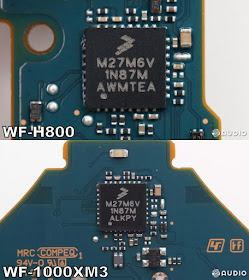 |
| USB micro-controller, MKL27Z64VFM4 - source: http://www.52audio.com |
Now looking at the earbuds more closely. Looks like there is no waterproofing, only a black foam surround to keep dust out. I will be looking forward to any future teardowns of the WF-SP800N since it has a waterproof rating if IPX5.
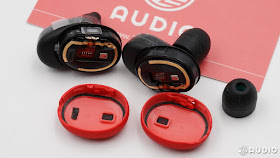 |
| source: http://www.52audio.com |
Close up of the foam tape/surround. The hole for the microphone is also covered by a small mesh to minimize the entrance of dust. I am sure one could work out in these, but I would not mix these earbuds with rain and jogging.
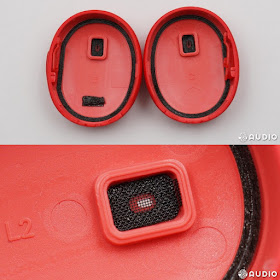 |
| source: http://www.52audio.com |
The Bluetooth antenna on the WF-H800 is also integrated into the plastic like in the WF-1000XM3, but is gold in colour, and not silver. Not sure if the colour/material has any effect in the reception/connection. The MEMS microphone can be seen in the photo below on the right side of the photo. If the antenna ever breaks in the earbuds, looks like the entire plastic piece needs to be replaced in order to replace it.
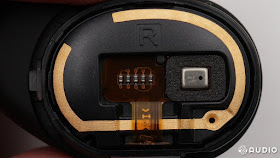 |
| source: http://www.52audio.com |
Now diving into the inside of the device more deeply. The main PCB is located directly underneath the Bluetooth antenna and microphone. The first thing that pops out is the MT2811S and the Q128FWY, both shared with the WF-1000XM3 and WI-1000XM2. I would venture to guess we will see both components in the WF-SP800N and WF-XB700.
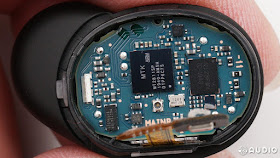 |
| source: http://www.52audio.com |
On the other underside of the PCB, we have a shielded section identical to the WF-1000XM3.
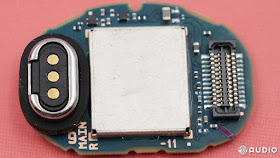 |
| source: http://www.52audio.com |
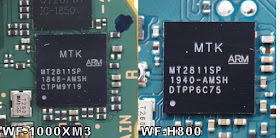 |
| source: http://www.52audio.com |
Here is a quick comparison between the Mediatek MT2811S chips in the WF-1000XM3 and WF-H800. Again I am not 100% certain the middle line is the production date but if it is, then the WF-H800 chip is from the 40th week of 2019, or September 29th to October 5th, 2019. The WF-1000XM3 date would be week 48, 2018, or November 26 to December 2nd, 2018
Finally, let us look at the internal battery in the earbuds. Seems Sony went for another supplier here, Zenipower rather than Varta. The battery is a Li-ion rated at 0.24Wh 3.7V, or 64.86mAh. The WF-1000XM3 uses the Varta CP1254 Li-ion battery rated at 0.23Wh 3.7 or 63mAh. Not sure if the minimal difference in capacity will make any big difference in listening time, but it is interesting to see that Sony has used a different brand. Perhaps Sony uses both batteries, the Z55 and CP1254 for either headsets.
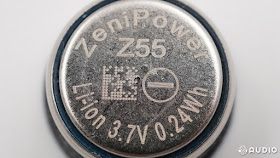 |
| source: http://www.52audio.com |
Source: 52Audio.com


great to see tear downs of Sony's stuff, too bad the wf-h800 is not on sale here.
ReplyDeleteWhere is HERE exactly?
DeleteI'm in the UK.
Delete